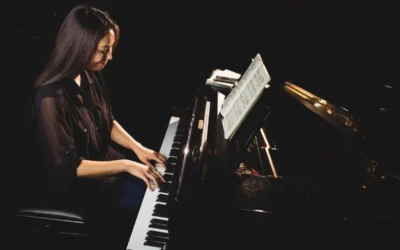
Sight reading tips from a piano teacher
As commited piano teachers, we encourage our students to practice as much sight-reading as possible.
Not only it builds up confidence and self-esteem, but it is also an ability that stays with you all your life.
Its real meaning refers to the ability of playing an unfamiliar piece without prior rehearsal.
It is not a gift as it is sometimes believed.
Sight-reading represents a complex skill that needs to be worked out throughout your piano lessons and practice time.
BEFORE SIGHT READING
How do you prepare for sight reading?
What is the first step to take before sight reading a piece?
You might be about to sight read in a graded music exam or just at home, trying to learn a new piece.
Either way, allow yourself some time to answer these questions before starting:
Clefs
Pianists associate the treble clef with the right hand and high notes and the bass clef with the left hand and low notes.
However, it is advisable to ensure as sometimes both hands might be written in the same clef.
Key signature
In other words, those sharps and flats showed at the beginning which affect all notes of one letter.
Find the main chords of that key (tonic I, subdominant IV and dominant V) as well as the relative minor/mayor or neightbour keys.
Play them and their scales to get your fingers used to the key itself.
Accidentals
Make sure you have found all accidental signs scattered over the piece.
Place your hands
Identifying the highest and lowest notes will help you choose a suitable hands position.
If there is any big leap, read it and find your way to get there.
Tempo
In order to decide a suitable tempo before sight reading the piece, pay attention to the quickest values and determine an steady pace in relation to them.
Scales and arpeggios
A run of notes close to each other will be likely to be a scale while notes from space to space or from line to line might build an arpeggio.
Structure
Music usually has a regular structure of 8 bars-phrases.
Try to identify it and spot any similarity you might find.
Do not forget to be musical and give those 8 bars unity.
Our Sight Reading Courses
WHEN SIGHT READING
How does reading ahead improve sight reading?
At this point we should have some valuable information about the piece without having played any single note yet.
Always bear in mind the following tips while playing:
A good sense of rhythm
This is more important than playing all the notes correctly.
In case you can’t continue playing both hands, decide quickly which one can be sacrificed for the music flow´s sake.
Try not to stop and keep counting.
Music rests
They are as important as the notes themselves.
Do not hold on when there should be silence.
Rather, look ahead and read further to gain fluency.
Keep your eyes on the music
Pianists like Angela Hewitt recommend to get used to the habit of keeping your eyes on the score, feeling the keys before pressing them, and only looking back at the keyboard to secure large leaps.
Improve your music theory skills
A good understanding of harmony and music theory will help you master scales, broken chords or arpeggios collectively and stop recognising them note by note.
Play lots of music, it pays off!
Most Recent Posts
Join the Academy
Piano Lessons
Music Theory



